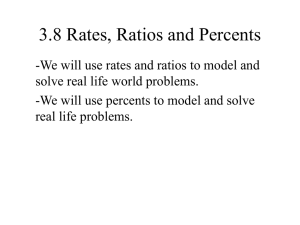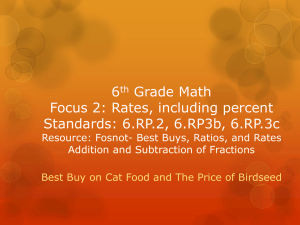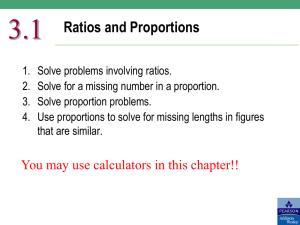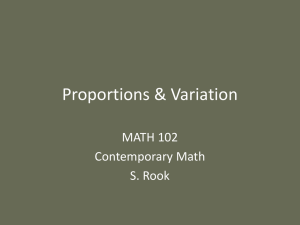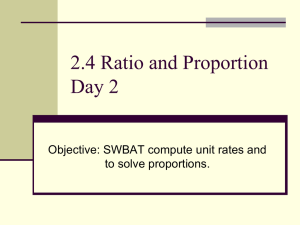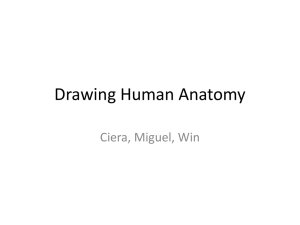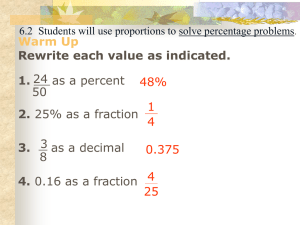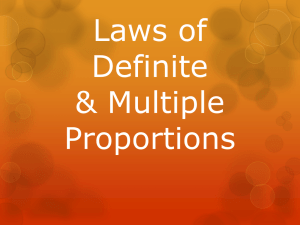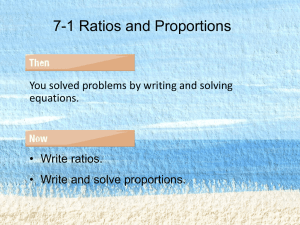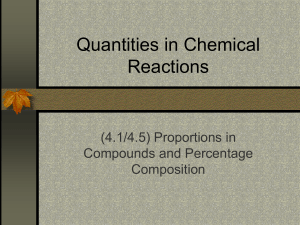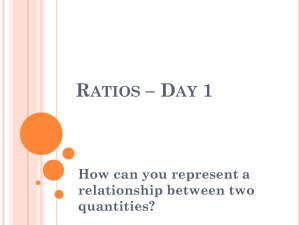Chapter 1
advertisement
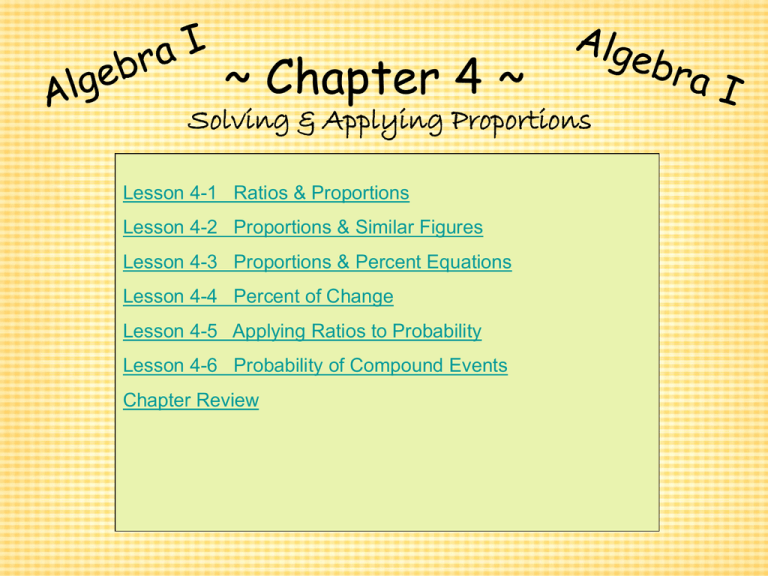
~ Chapter 4 ~ Solving & Applying Proportions Lesson 4-1 Ratios & Proportions Lesson 4-2 Proportions & Similar Figures Lesson 4-3 Proportions & Percent Equations Lesson 4-4 Percent of Change Lesson 4-5 Applying Ratios to Probability Lesson 4-6 Probability of Compound Events Chapter Review Ratios & Proportions Cumulative Review Ratios & Proportions Notes A ratio is a comparison of 2 numbers by division. It is represented as a:b or a/b where b ≠ 0. A unit rate is a ratio in which the denominator is 1. If a 25 oz. box of cereal costs $3.59 and a 17 oz box of cereal costs $2.99, determine the unit rate for each. Which is the better buy? Proportion – shows two ratios that are equal. a/b = c/d, where b ≠ 0 & d ≠ 0 You can solve proportions by multiplying by the LCD or using cross products! Ratios & Proportions Practice 4-1 Proportions & Similar Figures Notes Similar Figures – same shape but not necessarily the same size. “~” means “similar to”. In similar figures… corresponding angles are congruent and corresponding sides are proportional. In the following figures where ABC ~ DEF, find x. AB = AC DF DE 15 = 21 10 x Proportions & Similar Figures Notes Applying Similarity A tree casts a 26 ft shadow. A boy standing nearby casts a 12 ft shadow. His height is 4.5 ft. How tall is the tree? 26 = x 12 4.5 A house casts a 56 ft shadow. A girl standing nearby casts a 7.2 ft shadow. Her height is 5.4 ft. What is the height of the house? Scale drawing – an enlarged or reduced drawing that is similar to an actual object or place. (maps, floor plans, blueprints, etc) The scale for the map is 1 in = 10 miles. How far is it from Valkaria to Wabasso? Valkaria to Wabasso is 1.75 in. What is the distance from Grant to Gifford? Proportions & Similar Figures Homework Practice 4-2 all Proportions & Percent Equations Practice 4-2 Proportions & Percent Equations Notes Finding the Percent… What percent of 80 is 18? Part 18 = x Whole 80 100 80x = 1800 x = 22.5% What percent of 40 is 30? Finding the part… Find 75% of 320 Part 75 = x Whole 100 320 100x = 24,000 x = 240 Find 30% of 40… Proportions & Percent Equations Notes Finding the whole… Carlos worked 31.5 hours at a hospital as a volunteer. This represents 87.5% of his school’s requirement for community service. How many hours does his school require for community service? Part 31.5 = 87.5 Whole x 100 87.5x = 3150 x = 36 hours Using a percent equation… (1) What is 85% of 320? (% as decimal) x whole = part (2) 393 is 60% of what number? (3) What percent of 170 is 68? Percents greater than 100% and less than 1%... What percent of 90 is 135? Proportions & Percent Equations Notes x · 90 = 135 x = 1.5 (convert to percent ~ multiply by 100) 150% 105 is 125% of what number? What percent of 320 is 1.6? A store advertises sneakers on sale for 33% off. The original price of the sneakers is $56. Estimate the amount the sneakers would be marked down. Estimate the sale price. Homework ~ Practice 4-3 odd Percent of Change Practice 4-3 Percent of Change Notes Percent of Change = amount of change original amount Percent of change can be an increase or decrease… (1) Find the percent of change if the price of a CD increases from $12.99 to $13.99. Round to the nearest percent. 13.99-12.99 = 1 12.99 12.99 0.07698 = 0.08 = 8% increase (2) In 1990, there were 1330 registered alpacas in the U.S. By the summer of 2000, there were 29,856. What was the percent of increase in registered alpacas? Round to the nearest percent. 29,856 – 1330 = 1330 28,526 1330 = 21.448 = 2145% increase Percent of Change Notes Percent of Error The greatest possible error in a measurement is one half of that measuring unit. To find the greatest possible error… Look at the smallest measurement unit. For example: (1) You measure the mass of a rock and read the scale to measure 3.3 g. What is the greatest possible error? The mass was measured to the nearest ________, 0.1 g So half of 0.1 g is _________. 0.05 g (2) You measure a desk top to be 25 cm wide. What is the greatest possible error in your measurement? Finding maximum & minimum areas You measure a room to be 15 ft by 10 ft. What is the maximum & minimum possible areas for the room. Greatest possible error = ______ So… 14.5 ft x 9.5 ft = 137.75 ft2 (min) & 15.5 ft x 10.5 ft = 162.75 ft2 (max) Percent of Change Notes Percent of Error = greatest possible error measurement So back to the 3.3 g rock… what is the percent of error? 0.05 = 0.0151515 = 1.5% 3.3 Desk top percent of error? 0.5 = 0.02 = 2% 25 Homework Practice 4-4 odd Applying Ratios to Probability Practice 4-4 Applying Ratios to Probability Notes Probability – P(event) – how likely it is that something will occur. Outcome – result of a single trial. (omg – what happened?) (favorable or unfavorable) Event – any outcome or group of outcomes. Sample space – all of the possible outcomes. Theoretical probability – P(event) = number of favorable outcomes number of possible outcomes Probablity can be written as a fraction, a decimal or a percent. Probability ranges from 0 to 1. 0 would be an impossible event, 1 would be certain… Suppose you write the names of the days of the week on identical pieces of paper. Find the theoretical probability of picking a piece of paper at random that has the name of a day that starts with the letter T. What is the probability of rolling an even number on a number cube? A jar contains all the letters of the alphabet on wooden squares. What is the probability of drawing a vowel? Applying Ratios to Probability Notes Complement of an event is all the outcomes not in the event. The sum on an event and its complement is always equal to 1.. So… P(event) + P(not event) = 1 or P(not event) = 1 – P(event) Find the probability of not picking a piece of paper at random that has the name of a day that starts with the letter T. What is the complement of rolling an even number on a number cube? A jar contains all the letters of the alphabet on wooden squares. What is the probability of not drawing a vowel? Experimental probability = P(event) = number of times an event occurs number of times the experiment is done The manufacturer decides to inspect 2500 skateboards. There are 2450 skateboards that have no defects. Find the probability that a skateboard at random has no defects. The same manufacturer has 8976 skateboards in its warehouse. If the probability that a skateboard has no defect is 99.2%, how many are likely to have no defect. Probability of Compound Events Practice 4-5 Probability of Compound Events Notes Independent events – events that do not influence one another. Probability of two independent events P(A and B) = P(A) · P(B) Suppose you roll a red number cube and a blue number cube. What is the probability that you will roll a 5 on the red cube and a 1 or 2 on the blue cube? Suppose you roll 2 number cubes. What is the probability that both will be a number less than 6? Less than 5? (If you choose an item from a container and replace the item and choose again, the rules for independent events apply) Dependent Events – events that influence each other. Probability of two dependent events P(A then B) = P(A) · P (B after A) A bag contains 6 white counters, 5 red counters, and 19 counters of other colors. Find the probability of choosing a white and then a red counter if you do not replace the first counter before choosing the second counter. Probability of Compound Events Homework Homework - Practice 4-6 & Review Chap 4 Probability of Compound Events Practice 4-6 ~ Chapter 4 ~ Chapter Review ~ Chapter 4 ~ Chapter Review
